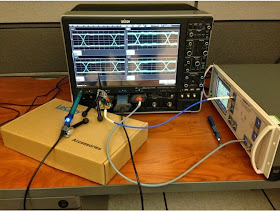 |
| Figure 1: Experimental setup for comparing a source-referred signal to an unloaded signal |
Let's go a little further into this topic with a real-world example. Using good coaxial cable, we hooked up a pattern generator with a fast rise time of 25 ps (10-90%) to a Teledyne LeCroy PCF2000 probe deskew fixture. The fixture, in turn, was connected to the Channel 2 input of a Teledyne LeCroy SDA820Zi-A 20-GHz oscilloscope (Figure 1). With the interposition of the deskew fixture, probes can easily be connected to and disconnected from the signal path, allowing the Channel 2 input to see either the loaded or unloaded signal.
 |
| Figure 2: The loaded input signal (yellow) compared with the input-referred probed signal (red) |
First, we set the pattern generator to output a low-frequency (<100 MHz) square wave. Because the signal rise time is still very fast compared to the system rise time, we can create a good approximation of the step response of the overall measurement system. We averaged the signal over 100 acquisitions to weed out random noise.
 |
| Figure 3: The unloaded signal (green) compared with the source-referred probed signal (blue) |
By removing the probe, saving the now-unloaded Channel 2 signal to memory, and then replacing the probe, we can also compare the unloaded signal (green M2 trace) to the source-referred probed signal (blue C3 trace) as shown in Figure 3. Referring to the amplitude measurements below the waveforms, note that the probe correction has removed the amplitude discrepancy caused by the probe loading. The amplitude measurements for the unloaded and probed signals nearly agree, with a difference of <0.5 mV.
Next, let's consider a more practical example of eye diagrams. In this case, the physical setup is the same, but we replaced the input signal with a 3-Gb/s PRBS7 pattern.
 |
| Figure 4: Four 3-Gb/s PRBS7 eye diagrams |
Note the similarity of shapes for both the unloaded and loaded conditions. What this is intended to show is that if one assumes that the probe is calibrated and corrected for properly, the signal seen on screen will be an accurate representation of the input. But one must still be aware of the probe-correction philosophy in play: Is my signal an accurate representation of the unloaded source signal, or is it of the loaded probe input signal? Hopefully, we've helped clarify this distinction in interpreting measurement results.
No comments:
Post a Comment